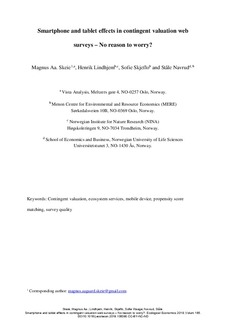| dc.contributor.author | Skeie, Magnus Aa. | |
| dc.contributor.author | Lindhjem, Henrik | |
| dc.contributor.author | Skjeflo, Sofie Waage | |
| dc.contributor.author | Navrud, Ståle | |
| dc.date.accessioned | 2019-12-03T10:27:50Z | |
| dc.date.available | 2019-12-03T10:27:50Z | |
| dc.date.created | 2019-08-06T14:54:20Z | |
| dc.date.issued | 2019 | |
| dc.identifier.issn | 0921-8009 | |
| dc.identifier.uri | http://hdl.handle.net/11250/2631455 | |
| dc.description.abstract | Stated preference (SP) web surveys are increasingly completed on mobile devices such as smartphones and tablets instead of computers. Due to differences in technical attributes and response contexts of the devices, this trend may affect the quality of the survey data and elicited welfare measures. Little is known of such device effects in SP research. In the first such study of its kind, we compare willingness to pay (WTP) and response quality between devices in a large, national contingent valuation survey. Propensity score matching is used to distinguish device effects from observed sample composition effects due to self-selection. We find significantly higher WTP for smartphone respondents in the first out of four sequential WTP questions, and no differences for tablets. Concerning data (response) quality, results are mixed, but not consistently lower for smartphones and tablets compared to computers. Measured by indicators of response randomness, shares of don't know and protest zeros, smartphone responses even show signs of higher quality. Only in terms of the extent of internal scope sensitivity, do smartphones and tablets fare somewhat worse than computers. Overall, our results do not indicate substantial loss of response quality or differences in welfare measures for mobile devices. Contingent valuation Ecosystem services Mobile device Propensity score matching Survey quality | |
| dc.language.iso | eng | nb_NO |
| dc.rights | Attribution-NonCommercial-NoDerivatives 4.0 Internasjonal | * |
| dc.rights.uri | http://creativecommons.org/licenses/by-nc-nd/4.0/deed.no | * |
| dc.title | Smartphone and tablet effects in contingent valuation web surveys – No reason to worry? | nb_NO |
| dc.type | Journal article | nb_NO |
| dc.type | Peer reviewed | nb_NO |
| dc.description.version | acceptedVersion | |
| dc.source.volume | 165 | nb_NO |
| dc.source.journal | Ecological Economics | nb_NO |
| dc.identifier.doi | 10.1016/j.ecolecon.2019.106390 | |
| dc.identifier.cristin | 1714394 | |
| dc.relation.project | Norges forskningsråd: 255777 | nb_NO |
| dc.relation.project | Andre: Norwegian Coastal Administration | nb_NO |
| cristin.unitcode | 192,11,0,0 | |
| cristin.unitname | Handelshøgskolen | |
| cristin.ispublished | true | |
| cristin.fulltext | postprint | |
| cristin.qualitycode | 1 | |

